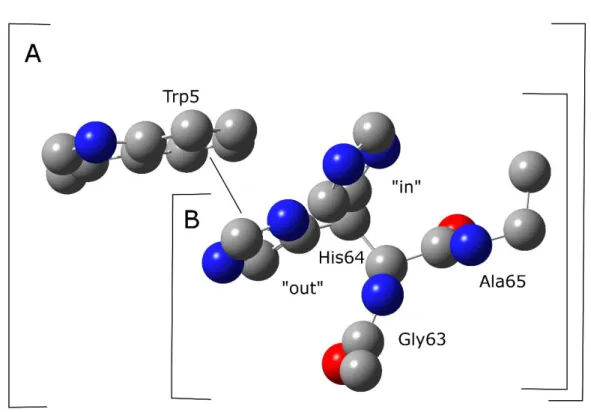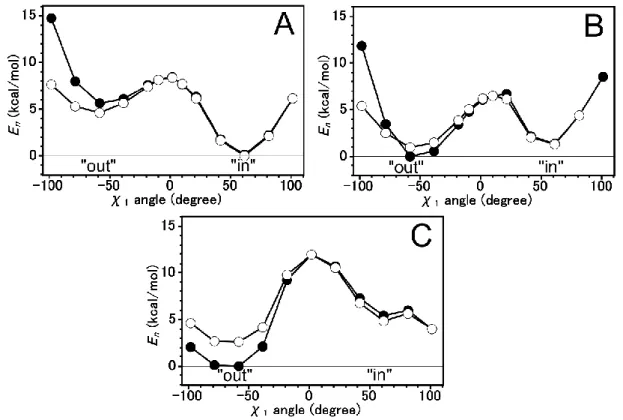Theoretical Studies of the Dependence of
Chemical Reaction on Tautomeric Form of His64 in the Active Site of Human Carbonic Anhydrase
?
著者 ムハマド コイマツ
著者別表示 Muhamad Koyimatu journal or
publication title
博士論文要旨Abstract 学位授与番号 13301甲第4143号
学位名 博士(理学)
学位授与年月日 2014‑09‑26
URL http://hdl.handle.net/2297/40321
Creative Commons : 表示 ‑ 非営利 ‑ 改変禁止 http://creativecommons.org/licenses/by‑nc‑nd/3.0/deed.ja
Theoretical Study of The Dependence of Chemical Reaction on Tautomeric form of
His64 in The Active Site of Human Carbonic Anhydrase II
ヒト由来炭酸脱水酵素 II の化学反応性の活性部位 His64互 変異性依存性に関する理論的研究
Graduate School of Natural Science and Technology Kanazawa University
Major Subject: Mathematical and Physical Sciences Course: Computational Science
1123102011
Name: Muhamad Koyimatu
Abstract
Human carbonic anhydrase II (HCA II) catalyzes the reversible hydration of CO2 to HCO3-
and proton. The productive proton is transferred from the zinc-bound water to the buffer molecule in bulk-water via His64 in the enzyme. NMR studies suggest that the tautomerization can be associated with the proton-transfer at neutral pH. X-ray data of HCA II show that His64 has two types of orientations, "in" and "out” at neutral pH. The properties of the imidazole side chain of His64 should be tuned by Trp5, in which the π-stacking interaction can occur in such aromatic rings. In this study, we calculated the π-stacking interaction energy in the Trp5-His64, including two tautomerization (N1-H and N2-H tautomer) and protonated form (imidazolium ion) model by using DFT/MP2 calculations. The results shows that the -stacking interaction between the indole ring and the imidazole ring in “out” conformation can be seen: the energy of
-stacking interaction, 1.5 kcal/mol, can be estimated for N1-H tautomer, 3.2 kcal/mol for N2-H tautomer, and 3.9 kcal/mol for imidazolium ion. These suggest that the rotational motion of His64 cannot be required in the proton-transfer process, but a flexible motion may occur in the each “in” and “out” conformation.
[Introduction]
Carbonic Anhydrase (CA) is zinc-containing enyme that catalyses the reversible hydration of carbon dioxide to form bicarbonate and excess proton.
CO2 + H2O ⇋ HCO3- + H+
Human Carbonic Anhydrase II (HCA II) has the fastest value among those of CA isozymes. Histidine at position 64 is accepted to facilitate the transfer of the productive proton from the zinc-bound water to a buffer molecule in bulk-water through intervening hydrogen bonded water molecules.
The final step of proton transfer has been assumed to be connected with a rotational or swinging motion of the side chain of His64 because this residue has two conformations,
“in” and “out”. The properties of the imidazole side chain of His64 should be tuned by Trp5 because the indole ring is located near to imidazole ring of His64 (~4 Å), in which the π-stacking interaction can occur in such aromatic rings. According to the crystal structure, the indole ring of Trp5 planar parallel to the imidazole ring of the “out”
conformation of His64 is an off-centered structure, in which a face-to-face of -stacking interaction should be formed to stabilize the two aromatic rings.1 A researcher reported that His64 has a potential to be rotated in the catalysis by using molecular dynamic simulations.2 However, the indole ring of Trp5 has not been considered in the model system. In addition, the 15N-NMR study of HCA II suggests that the interconversion of two tautomeric forms of His64 through protonated form, called as tautomerization3. The three form of imidazole ring, N1-H tautomer, N2-H tautomer, and imidazolium ion also considered.
In order to investigate the possibility that the indole ring of Trp5 interrupts the rotational motion of His64, the His64 and Trp5-containing model was constructed, and estimate the effect of the -stacking interaction energy.
[Experiment]
Some model system that consists of His64 and Trp5 was constructed (Figure 1). The coordinates were obtained from the protein database (PDB) file of the crystal structure of HCA II (2CBA). The 1 angle of His64 was adjusted manually to clearly see the interaction energy between His64 and Trp5. The pKa value for the imidazole ring is approximately 7.0; both the acid and base forms are present. The acid form is imidazolium ion, and the base form is the N1-H tautomer and the N2-H tautomer.
Considering that, we simulated all three forms of imidazole.
The density-functional theory (DFT) method was employed to optimize the position of hydrogen atoms in model system. The position of hetero atoms (C, N, and O) was fixed.
Considering electron-electron interaction, DFT method was not enough to estimate the
-stacking interaction. The second-order Møller-Plesset perturbation (MP2) theory applied to the optimized structure from MP2 calculation.
[Results and Discussion]
a. Assessing the stacking interaction in the active site of HCA II
Some calculation methods and basis sets was examined to determine the existence of - stacking interaction between Trp5 and the “out” conformation of His64 in HCA II. The MP2 combined with 6-311++G(d,p) basis set can determine the electron-electron interaction and estimated the -stacking interaction energy value of Trp5 and His64 is 1.73 kcal/mol, obtained from subtracting the energy of model structure with Trp5 (B, 2.09 kcal/mol) to model structure without Trp5 (A, 0.36 kcal/mol), as shown in Table 1.
In order to confirm this suggestion, the imidazole ring of His64 is substituted with benzene ring, called Phe64. This structure gives a -stacking interaction energy 1.83 kcal/mol.
Figure 1.The model system included His64 and Trp5.
Table 1 E for each model structure and calculation methods in kcal/mol
Method and Basis sets A (His64) B (Trp5- His64)
C (Tyr7- His64)
D (Trp5- Tyr7-His64)
B3LYP/6-31G(d,p) 0.50 0.22 1.21 0.78
B3LYP/6-311++G(d,p) 1.56 1.11 2.72 2.43
MP2/6-31G(d,p) 0.37 0.88 0.89 1.31
MP2/6-311++G(d,p) 0.36 2.09 0.94 2.60
b. Interaction energy of two tautomeric forms and one protonated form
The calculated energy values were plotted as a function of the 1 angle of the His64 to investigate the profile of the -stacking interaction. In order to compare the energy profile of structure with Trp5 (Model AB) and without Trp5 (Model B), both energy profiles were plotted in one figure. At high 1 angle value, the lowest (even no) - stacking interaction was expected. Both energy profiles were superimposed at this point.
The highest -stacking interaction occurs at the 1 angle around -50°, where His64 form a face-to-face parallel interaction with Trp5.
The model structure was calculated using three types of His64, N1-H tautomer, N2-H tautomer, and imidazolium ion. N2-H tautomer and imidazolium ion has the “out”
conformation more stable than “in” conformation. While the N1-H tautomer has the opposite condition, as shown in Figure 2.
The interaction energy can be described by Equation 1.
∆𝐸𝑖 = 𝐸𝐴𝐵− (𝐸𝐴+ 𝐸𝐵) Equation 1
Using interaction energy, the -stacking interaction effect between “out” conformation and “in” conformation can be estimated. The highest -stacking interaction occurs in imidazolium ion by 3.9 kcal/mol, followed by N-2 H tautomer by 3.2 kcal/mol, and the lowest N1-H tautomer by 1.5 kcal/mol. The detail of interaction energy profile can be seen in Figure 3.
Figure 2. The energy profile comparison of structure with Trp5 (closed circle) and structure without Trp5 (open circle) for N1-H tautomer (A), N2-H tautomer (B), and imidazolium ion (C) of His64.
Figure 3. The interaction energy profiles of N1-H tautomer (A), N2-H tautomer (B), and imidazolium ion (C).
[Conclussion]
The -stacking interaction on the active site of HCA II was occurring between “out”
conformation of His64 and Trp5. As a result there is extra stabilization energy in the structure. The MP2/6-31++G(d,p) was well suited calculation level that included - stacking interaction. The value of -stacking was 1.73 and 1.83 kcal/mol.
The -stacking interaction has an impact in the His64 rotational motion. The potential energy profile of three types of imidazole form of His64 shows that there is a stabilization in the “out” conformation when Trp5 added in the model structure. The stabilization at “out” conformation make the energy barrier of rotation between “in” and
“out” conformation increased. This implies that the His64 does not required to do rotational motion in the proton transfer process, but a flexible motion may occur between “in” and “out” conformation.
[References]
1. D.N. Silverman and R. McKenna: Acc. Chem. Res. 40 (2007) 669.
2. C. Maupin and G.A. Voth: Biochemistry. 46 (2007) 2938.
3. H. Shimahara, et al.: J. Biol. Chem. 282 (2007) 9646.


